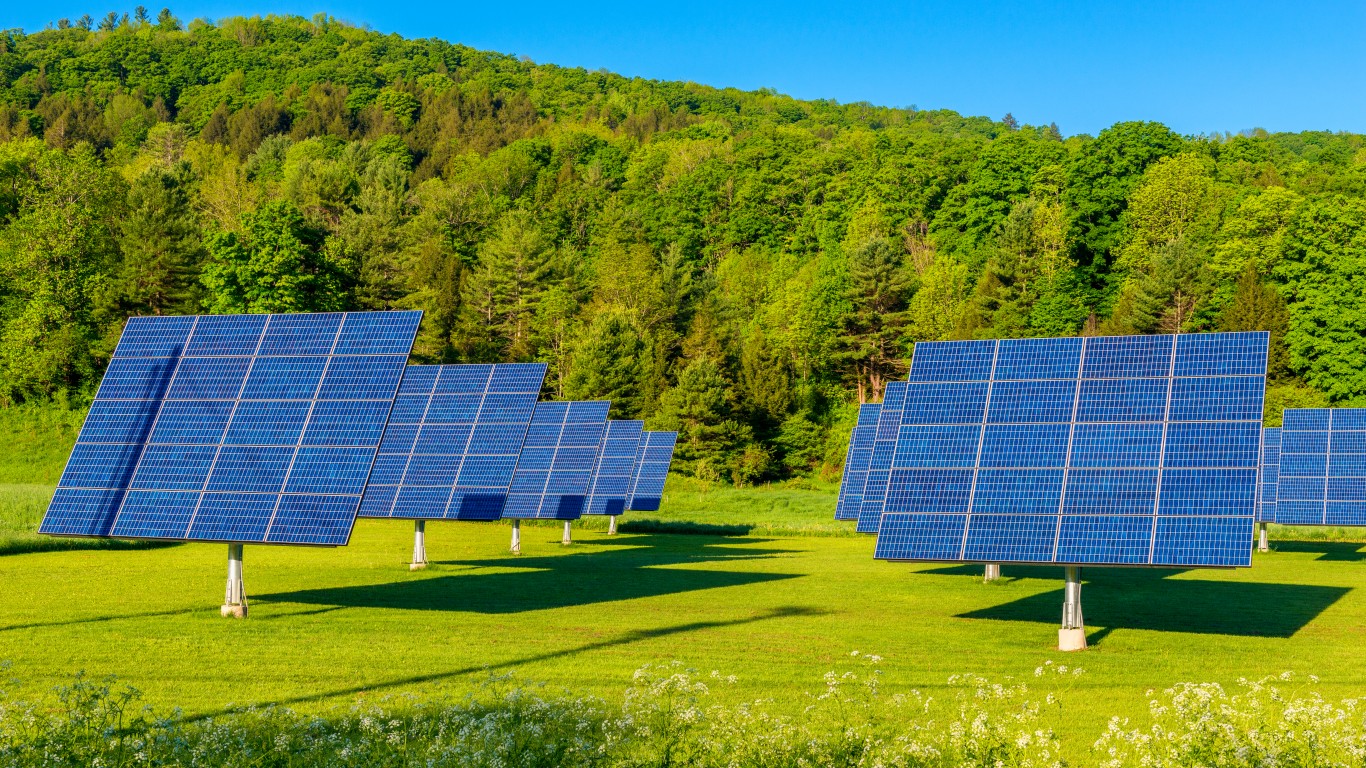Energy
Green Electricity Outshines Coal for the First Time in US

Published:
Last Updated:

U.S. electricity generation is (slowly) going green. At the end of April, power generation capacity from renewable sources (hydropower, biomass, geothermal, solar and wind) for the first time surpassed the generation capacity of coal-fired power plants. Not by much, but with planned capacity additions, renewables are poised to widen the gap as more coal-fired plants are retired.
According to data released earlier this week by the Federal Energy Regulatory Commission (FERC), renewables installed capacity equaled 21.56% of the nation’s total generation capacity in April, compared with coal-fired capacity of 21.55%. Natural gas–fired capacity accounts for 44.44% of U.S. power generation capability.
Just two new coal-fired projects are planned for completion by May 2022 that would add 867 megawatts (MW) of coal-fired generation, while 50 units with a total generating capacity of 13.3 gigawatts (GW) are slated for retirement. Of a total of what the FERC calls “high probability additions,” new wind capacity additions total 25.36 GW and new solar capacity additions will total 14.85 GW. That sums to about 54% of all newly added capacity by May 2022. Natural gas accounts for about 38% of added generation capacity by the same date.
The FERC also reported a total of all proposed additions to U.S. generation capacity of 275.79 GW. Again, only two coal-fired additions are being proposed, while 543 wind projects have been proposed that would add 101.4 GW of wind generation and 2,510 solar projects have been proposed that would add 84.7 GW of new solar capacity.
Still undecided is whether the shift to renewable sources will affect the amount of greenhouse gases emitted by U.S. electricity generators. In 2018, carbon emissions from all U.S. power plants rose year over year by 1.9%, from a drop of 78 million metric tons in 2017 to an increase of 34 million metric tons.
Last year’s increased emissions were mostly due to increased natural gas-fired generation. Natural gas emits about 40% to 50% less carbon dioxide than coal, but gas-fired capacity rose sharply last year. While natural gas is cleaner than coal, it should be considered a transition fuel until electricity is 100% generated from renewable sources.
About five years ago, the unsubsidized levelized cost of energy (LCOE) from wind power was $59 per megawatt-hour (MWh) and the unsubsidized LCOE from solar power was $79 per MWh. In 2018, wind’s LCOE had dropped to $42 and solar’s to $43.
LCOE is the average revenue per unit of electricity generated that would be required to recover the costs of building and operating a generating plant over an assumed financial life and duty cycle. According to a recent estimate from the U.S. Energy Information Administration, the LCOE of a power generation plant entering service in 2023 is $40.20 per MWh for advanced combined-cycle natural gas plants, $36.60 per MWh for onshore wind and $37.60 per MWh for solar photovoltaic.
The Trump administration’s continued support for coal makes lots of noise but little difference. The switch to natural gas and, ultimately, to renewables is driven by economics, not regulation and bluster. Jeff McDermott, managing partner at Greentech Capital Advisors, a boutique investment bank focused on clean energy, told CNN that when it comes to energy, “The public doesn’t want [coal]. And the world can’t take it. The Trump administration is playing political favorites, trying to prop up an industry that is technologically obsolete.”
By the end of this year, the coal-fired Navajo Generating Station in the Four-Corners area is set to shut down, removing 2.25 GW of capacity from the grid and costing more than 700 people their jobs, including about 340 employed at the Kayenta mine that supplied the plant’s coal. Nearly all those workers are members of either the Navajo Nation or the Hopi tribe.
The plant’s closing is an opportunity for the Navajo Nation, however. It has retained ownership of 500 MW of transmission capacity and hopes to develop the site into a utility-scale solar hub that receives power from other generators and feeds it out to far-flung customers. Repurposing closed coal-fired power plants (and some mining sites), while not yet a “thing,” is being reviewed in several states that have already experienced shutdowns, according to a report from the Institute for Energy Economics and Financial Analysis.
Last year, BloombergNEF projected that by 2050, global spending on new electric power generation would total $11.5 trillion. Of that total, 73% ($8.4 trillion) will be invested in solar and wind and another $1.5 trillion in other zero-carbon technologies like hydro and nuclear. Another $548 billion will be invested in battery capacity by 2050. Coal’s share of global power generation will drop from 38% to 11%. As impressive as that is, it’s probably not fast enough to keep global warming from rising by less than 2° Celsius.
If you’re like many Americans and keep your money ‘safe’ in a checking or savings account, think again. The average yield on a savings account is a paltry .4% today, and inflation is much higher. Checking accounts are even worse.
Every day you don’t move to a high-yield savings account that beats inflation, you lose more and more value.
But there is good news. To win qualified customers, some accounts are paying 9-10x this national average. That’s an incredible way to keep your money safe, and get paid at the same time. Our top pick for high yield savings accounts includes other one time cash bonuses, and is FDIC insured.
Click here to see how much more you could be earning on your savings today. It takes just a few minutes and your money could be working for you.
Thank you for reading! Have some feedback for us?
Contact the 24/7 Wall St. editorial team.